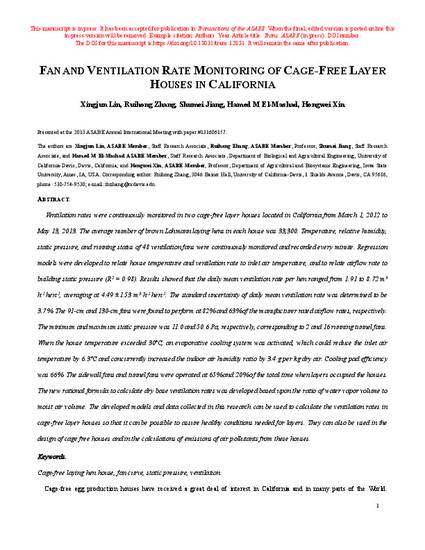
Ventilation rates were continuously monitored in two cage-free layer houses located in California from March 1, 2012 to May 13, 2013. The average number of brown Lohmann laying hens in each house was 33,300. Temperature, relative humidity, static pressure, and running status of 48 ventilation fans were continuously monitored and recorded every minute. Regression models were developed to relate house temperature and ventilation rate to inlet air temperature, and to relate airflow rate to building static pressure (R2 = 0.98). Results showed that the daily mean ventilation rate per hen ranged from 1.91 to 8.72 m3 h-1 hen-1, averaging at 4.49 ±1.53 m3 h-1 hen-1. The standard uncertainty of daily mean ventilation rate was determined to be 3.7%. The 91-cm and 130-cm fans were found to perform at 82% and 63% of the manufacturer rated airflow rates, respectively. The minimum and maximum static pressure was 11.0 and 50.6 Pa, respectively, corresponding to 2 and 16 running tunnel fans. When the house temperature exceeded 30ºC, an evaporative cooling system was activated, which could reduce the inlet air temperature by 6.3ºC and concurrently increased the indoor air humidity ratio by 3.4 g per kg dry air. Cooling pad efficiency was 66%. The sidewall fans and tunnel fans were operated at 65% and 20% of the total time when layers occupied the houses. The new rational formula to calculate dry base ventilation rates was developed based upon the ratio of water vapor volume to moist air volume. The developed models and data collected in this research can be used to calculate the ventilation rates in cage-free layer houses so that it can be possible to assure healthy conditions needed for layers. They can also be used in the design of cage free houses and in the calculations of emissions of air pollutants from these houses.
Available at: http://works.bepress.com/hongwei_xin/354/

This article is published as Lin, Xingjun, Ruihong Zhang, Shumei Jiang, Hamed M. El-Mashad, and Hongwei Xin. "Fan and Ventilation Rate Monitoring of Cage-Free Layer Houses in California." Transactions of the ASABE 61, no. 6 (2018): 1939-1950. DOI: 10.13031/trans.12831. Posted with permission.